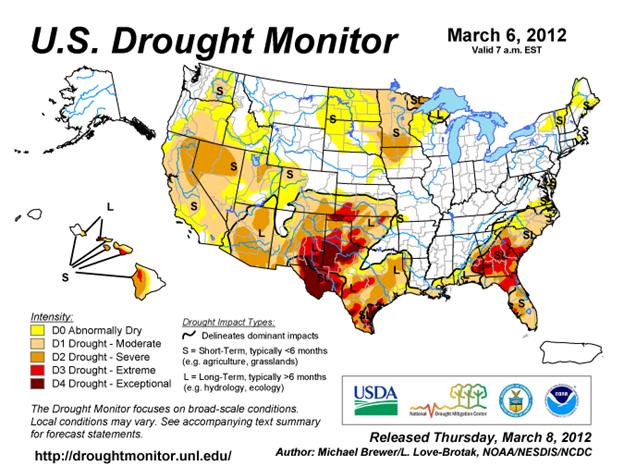
Agricultural News
Drought Still Shaping Southern Plains Wheat Crop
Fri, 09 Mar 2012 14:25:39 CST

Last year's drought across large swaths of the Southern Plains is continuing into this year with some exceptions. Mark Hodges, executive director of PGI Quality Based Marketing says the drought has already played a significant role in determining the outcome of this year's winter wheat crop. This is his analysis of how weather conditions will impact producers' decisions and results:
The 2012 HRW wheat crop has already been an amazing one (not unlike about any year). The crop year started with the effects of the 2011 drought defining how the crop was planted. Most producers "dusted in" the seed (with the exception of some areas of north central Oklahoma, north central Texas and south central Kansas...see Drought Monitor map below) with a hope there would eventually be enough moisture to get the crop up and develop some type of a root system that would sustain the plant through the winter. Because of the drought the soil profile had been depleted from 2' on down in many areas (again, the exceptions were areas of north central Texas, north central Oklahoma and south central Kansas).
Uncharacteristic rains in late October into November provided what most areas of the state needed to geminate the seed and establish an initial root system and tillers (stems). La Nina patterns have historically proven the Southern Great Plains will have above average temperatures over the winter months, this year was no exception. This coupled with timely moisture since October/November has allowed many wheat producers to take advantage of the forage that was produced for grazing. Anecdotal reports have been cattle gaining over 3# per day in many areas and producers having to pull cattle off early because the size of those going to the feedlot. The concern of the warmer temperatures on the crop however, has been plants developing first hollow stem (stem elongation and the head starting to move upward) earlier than normal. This process started for many varieties in mid-February. The concern is the plant will mature too rapidly to a point it will be susceptible to damage from a freeze (through mid-April).
The drought still has its grip on the many parts of the Southern Great Plains (western areas of the region especially) with very little deep soil profile moisture except for in the areas already noted. The most critical parts of the area are the Texas Panhandle, SW Oklahoma (southward into TX), the Panhandle of Oklahoma, SE Colorado and SW Kansas; many of these areas only have moist soil no more than a few inches deep. The remainder of the region, while having good moisture in the upper soil profile, has no deep moisture (exceptions noted) and so timely rains from this point forward will be critical for a good crop. Additionally, from this point forward the water demand of the plant will continue to increase until the crop reaches physiological maturity (late April to May).
So where are we vs. where we would like to be (in most areas)?
· Good root system development and tiller development (exceptions are areas noted above that are still under severe to extreme drought conditions).
· Most areas (exceptions noted) have good surface moisture, but no subsoil moisture.
· Many producers have been able to take advantage of forage production (again, exceptions noted).
· With timely moisture this crop still has potential.
· No current major disease or insect concerns emerging, but it is extremely early and a problem can develop very rapidly.
CONCERNS:
· MUST have timely moisture from this point forward.
· NO reserve (subsoil) moisture (exceptions noted)!
· TOO rapid plant development (could be a problem for many varieties with a spring freeze).
· Because of planting scenario above there was very little weed control done at planting (may equal discounts at harvest).
· Disease from this point forward is always a concern...with timely moisture come good conditions for disease development if the inoculums are present.
FINALLY:
Thoughts. Most producers must now purchase crop insurance to survive the devastating effects of a crop loss. Most were insured when the crop went in the ground although (dusted in). Because producers were not able to do the "normal" weed control measures in the fall this could be a dockage factor at harvest, plus cattle prices are still relatively high, plus the price of wheat has been stagnant to falling, plus ALL the hay was used up last year in the Southern Great Plains, plus wheat hay could be well over $100 a bale this spring, plus with any timely moisture this spring many areas of the state could yield 2 plus bales of hay per acre...haying or grazing would eliminate the risk from just before crop maturity to harvest (and we know there a lot of things that can happen in that time frame...and none of them are good). Crop insurance premiums could play a role. And last, because of the drought of 2011 cash flow for many producers may be very tight...this could influence the decision above!!!! (bird in the hand concept)
The point the is, the Southern Great Plains "could" see an above average number of acres go to graze out, hay, etc. (otherwise known as abandonment) this year.
--Mark Hodges, Executive Director, PGI Quality Based Marketing, LLC
WebReadyTM Powered by WireReady® NSI
Top Agricultural News
More Headlines...



















